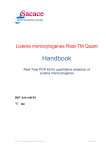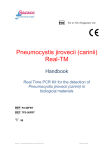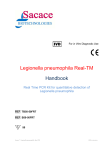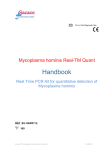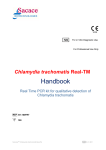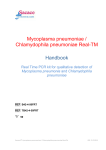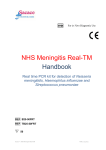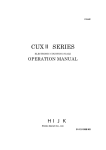Download Trichomonas vaginalis TM SC RG iQ A MX ENG ver - bio
Transcript
IVD For in Vitro Diagnostic Use Trichomonas vaginalis Real-TM Handbook Real Time PCR kit for qualitative detection of Trichomonas vaginalis REF B6-100FRT REF TB6-100FRT 100 Sacace™ Trichomonas vaginalis Real-TM VER. 21.03.2013 Sacace™ Trichomonas vaginalis Real-TM VER. 21.03.2013 NAME Trichomonas vaginalis Real-TM INTRODUCTION STDs (sexually transmitted diseases) refer to a variety of bacterial, viral and parasitic infections that are acquired through sexual activity. Some STDs, such as syphilis and gonorrhea, have been known for centuries — while others, such as HIV, have been identified only in the past few decades. STDs are caused by more than 25 infectious organisms. As more organisms are identified, the number of STDs continues to expand. Common STDs include: chlamydia, gonorrhea, herpes, HIV, HPV, syphilis, gardnerella and trichomoniasis. The development of tests based on nucleic acid amplification technology has been the most important advance in the field of STD diagnosis. Because nucleic acid amplification is exquisitely sensitive and highly specific, it offers the opportunity to use noninvasive sampling techniques to screen for infections in asymptomatic individuals who would not ordinarily seek clinical care. INTENDED USE Kit Trichomonas vaginalis Real-TM is a test for the qualitative detection of Trichomonas vaginalis in the urogenital swabs, urine, prostatic liquid and other biological materials. PRINCIPLE OF ASSAY Kit Trichomonas vaginalis Real-TM is based on two major processes: isolation of DNA from specimens and Real Time amplification. Trichomonas vaginalis DNA is extracted from the specimens, amplified in Real Time PCR and detected using fluorescent reporter dye probes specific for Trichomonas vaginalis DNA and Internal Control. Internal Control (IC) serves as an amplification control for each individually processed specimen and to identify possible reaction inhibition. IC is detected in a channel other than the Trichomonas vaginalis DNA. Sacace™ Trichomonas vaginalis Real-TM VER. 21.03.2013 MATERIALS PROVIDED Module No.1: Real Time PCR kit (B6-100FRT) Part N° 2 – “T.vaginalis Real-TM”: Real Time amplification • PCR-mix-1-FL, 1,2 ml; • PCR-mix-2-FRT, 2 x 0,35 ml; • TaqF Polymerase, 2 x 0,03 ml; • Pos C+, 0,2 ml; • Negative Control C-, 1,2 ml;* • Internal Control IC, 1,0 ml;** • DNA-buffer, 0,5 ml; Contains reagents for 110 tests. Module No.2: Complete Real Time PCR test with DNA purification kit (TB6-100FRT) Part N° 1 – “DNA-sorb-A”: Sample preparation • Lysis Solution, 2 x 15 ml; • Sorbent, 2 x 1,0 ml; • Washing Solution, 2 x 50 ml; • DNA-eluent, 2 x 5 ml; • Transport medium , 30 ml. Contains reagents for 100 tests. Part N° 2 – “T.vaginalis Real-TM”: Real Time amplification • PCR-mix-1-FL, 1,2 ml; • PCR-mix-2-FRT, 2 x 0,35 ml; • TaqF Polymerase, 2 x 0,03 ml; • Pos C+, 0,2 ml; • Negative Control C-, 1,2 ml;* • Internal Control IC, 1,0 ml;** • DNA-buffer, 0,5 ml; Contains reagents for 110 tests. *must be used in the isolation procedure as Negative Control of Extraction. **add 10 µl of Internal Control during the DNA isolation directly to the sample/lysis mixture (see DNA-Sorb-A REF K-1-1/A protocol). Sacace™ Trichomonas vaginalis Real-TM VER. 21.03.2013 MATERIALS REQUIRED BUT NOT PROVIDED Zone 1: sample preparation: • DNA extraction kit (Module No. 1) • Biological cabinet • Desktop microcentrifuge for “eppendorf” type tubes • Dry heat block • Vortex mixer • Pipettes • Sterile pipette tips with filters • 1,5 ml polypropylene sterile tubes • Biohazard waste container • Refrigerator, Freezer Zone 2: Real Time amplification: • Real Time Thermal cycler • Reaction tubes • Workstation • Pipettes (adjustable) • Sterile pipette tips with filters • Vortex mixer • Freezer, refrigerator Sacace™ Trichomonas vaginalis Real-TM VER. 21.03.2013 STORAGE INSTRUCTIONS All components of the Trichomonas vaginalis Real-TM PCR kit (except for polymerase (TaqF) and PCR-mix-2-FRT) are to be stored at the temperature 2–8 ºC when not in use. All components of the Trichomonas vaginalis Real-TM PCR kit are stable until labeled expiration date. The shelf life of reagents before and after the first use is the same, unless otherwise stated. PCR-mix-1-FL is to be kept away from light. Polymerase (TaqF) and PCR-mix-2-FRT are to be stored at ≤ –16 °C STABILITY Trichomonas vaginalis Real-TM is stable up to the expiration date indicated on the kit label. The product will maintain performance through the control date printed on the label. Exposure to light, heat or humidity may affect the shelf life of some of the kit components and should be avoided. Repeated thawing and freezing of these reagents should be avoided, as this may reduce the sensitivity. QUALITY CONTROL In accordance with Sacace’s ISO 13485-Certified Quality Management System, each lot is tested against predetermined specifications to ensure consistent product quality. Sacace™ Trichomonas vaginalis Real-TM VER. 21.03.2013 WARNINGS AND PRECAUTIONS In Vitro Diagnostic Medical Device For In Vitro Diagnostic Use Only The user should always pay attention to the following: • Lysis Solution contains guanidine thiocyanate*. Guanidine thiocyanate is harmful if inhaled, or comes into contact with skin or if swallowed. Contact with acid releases toxic gas. (Xn; R: 20/21/22-36/37/38; S: 36/37/39). • Use sterile pipette tips with aerosol barriers and use new tip for every procedure. • Store extracted positive material (samples, controls and amplicons) away from all other reagents and add it to the reaction mix in a separate area. • Thaw all components thoroughly at room temperature before starting an assay. • When thawed, mix the components and centrifuge briefly. • Use disposable gloves, laboratory coats and eye protection when handling specimens and reagents. Thoroughly wash hands afterwards. • Do not eat, drink, smoke, apply cosmetics, or handle contact lenses in laboratory work areas. • Do not use a kit after its expiration date. • Dispose of all specimens and unused reagents in accordance with local authorities’ regulations. • Specimens should be considered potentially infectious and handled in a biological cabinet in accordance with appropriate biosafety practices. • Clean and disinfect all sample or reagent spills using a disinfectant such as 0.5% sodium hypochlorite, or other suitable disinfectant. • Avoid sample or reagent contact with the skin, eyes, and mucous membranes. If skin, eyes, or mucous membranes come into contact, rinse immediately with water and seek medical advice immediately. • Material Safety Data Sheets (MSDS) are available on request. • Use of this product should be limited to personnel trained in the techniques of DNA amplification. • The laboratory process must be one-directional, it should begin in the Extraction Area and then move to the Amplification and Detection Areas. Do not return samples, equipment and reagents to the area in which the previous step was performed. Some components of this kit contain sodium azide as a preservative. Do not use metal tubing for reagent transfer. * Only for Module No.2 Sacace™ Trichomonas vaginalis Real-TM VER. 21.03.2013 PRODUCT USE LIMITATIONS All reagents may exclusively be used in in vitro diagnostics. Use of this product should be limited to personnel trained in the techniques of DNA amplification (EN375). Strict compliance with the user manual is required for optimal PCR results. Attention should be paid to expiration dates printed on the box and labels of all components. Do not use a kit after its expiration date. SAMPLE COLLECTION, STORAGE AND TRANSPORT Trichomonas vaginalis Real-TM can analyze DNA extracted from: • cervical, urethral swabs: insert the swab into the nuclease-free 1,5 ml tube and add 0,2 ml of Transport medium. Agitate swabs in medium for 15-20 sec. • urine sediment : collect 10-20 ml of first-catch urine in a sterile container. Centrifuge for 30 min at 3000 x g, carefully discard the supernatant and leave about 200 µl of solution. Resuspend the sediment. Use the suspension for the DNA extraction. • prostatic liquid stored in “Eppendorf” tube; • seminal liquid: maintain semen for 40 min in darkness until liquefaction. Use 100 µl for the DNA extraction. It is recommended to process samples immediately after collection. Store samples at 2–8 °C for no longer than 24 hours, or freeze at –20/80°C. Transportation of clinical specimens must comply with country, federal, state and local regulations for the transport of etiologic agents. DNA ISOLATION The following kit is recommended: DNA-Sorb-A (Sacace, REF K-1-1/A) Please carry out DNA extraction according to the manufacture’s instruction. Add 10 µl of Internal Control during DNA isolation procedure directly to the sample/lysis mixture. (Note: the Sacace Internal Control is the same for all urogenital infection Real Time kits) Sacace™ Trichomonas vaginalis Real-TM VER. 21.03.2013 SPECIMEN AND REAGENT PREPARATION (reagents supplied with the module no.2) 1. Lysis Solution and Washing Solution (in case of their storage at +2-8°C) should be warmed up to 60–65°C until disappearance of ice crystals. Prepare required quantity of 1.5 ml polypropylene tubes including one tube for Negative Control of Extraction. 2. Add to each tube 10 µl of Internal Control and 300 µl of Lysis Solution. 3. Add 100 µl of Samples to the appropriate tube. 4. Prepare Controls as follows: • add 100 µl of C– (Neg Control) to the tube labeled Cneg. 5. Vortex the tubes and incubate for 5 min at 65°C. Centrifuge for 5-7 sec. If the sample is not completely dissolved it is recommended to re-centrifuge the tube for 5 min at a maximum speed (12000-16000 g.) and transfer the supernatant into a new tube for DNA extraction. 6. Vortex vigorously Sorbent and add 20 µl to each tube. 7. Vortex for 5-7 sec and incubate all tubes for 3 min at room temperature. Repeat this step. 8. Centrifuge all tubes for 30 sec at 5000g and using a micropipette with a plugged aerosol barrier tip, carefully remove and discard supernatant from each tube without disturbing the pellet. Change tips between the tubes. 9. Add 500 µl of Washing Solution to each tube. Vortex very vigorously and centrifuge for 30 sec at 10000g. Remove and discard supernatant from each tube. 10. Repeat step 9 and incubate all tubes with open cap for 5-10 min at 65°C. 11. Resuspend the pellet in 100 µl of DNA-eluent. Incubate for 5 min at 65°C and vortex periodically. 12. Centrifuge the tubes for 1 min at 12000g. 13. The supernatant contains DNA ready for amplification. If amplification is not performed in the same day of extraction, the processed samples can be stored at 2-8°C for at maximum period of 5 days or frozen at –20°/-80°C. PROTOCOL: The total reaction volume is 25 µl, volume of DNA sample - 10 µl. 1. Prepare required quantity of reaction tubes for samples (N) and controls (N+2). 2. Prepare in the new sterile tube 10*N µl of PCR-mix-1-FRT, 5*N µl of PCR-mix-2-FRT and 0,5*N µl of TaqF DNA Polymerase. Vortex and centrifuge briefly. 3. Add to each tube 15 µl of Reaction Mix and 10 µl of extracted DNA. Mix by pipetting. 4. Prepare for each panel 2 controls: ● add 10 µl of DNA-buffer to the tube labeled NCA (Negative Control of Amplification); ● add 10 µl of Positive Control C+ to the tube labeled C+ (PCR Positive Control); 5. Insert the tubes in the thermalcycler. Sacace™ Trichomonas vaginalis Real-TM VER. 21.03.2013 Amplification 1. Create a temperature profile on your instrument as follows: Rotor-type Instruments1 Step 1 2 3 Тemperature, °С 95 95 60 72 95 60 72 Plate- or modular type Instruments2 Time Repeats 15 min 5s 20 s 15 s 5s 20 s fluorescent signal detection 15 s 1 5 40 Тemperature, °С 95 95 60 72 95 60 72 Time Repeats 15 min 5s 20 s 15 s 5s 30 s fluorescent signal detection 15 s 1 5 40 1 For example Rotor-Gene™ 3000/6000/Q (Corbett Research, Qiagen) 2 For example, SaCycler-96™ (Sacace), CFX/iQ5™ (BioRad); Mx3005P™ (Agilent), ABI® 7300/7500/StepOne Real Time PCR (Applied Biosystems), SmartCycler® (Cepheid), LineGeneK® (Bioer) Fluorescence is detected at the 2nd step of Cycling 2 stage (60 °C) in FAM/Green and JOE/Yellow/Hex/Cy3 fluorescence channels. Trichomonas vaginalis is detected on the FAM (Green) channel, IC DNA on the JOE(Yellow)/HEX/Cy3 channel INSTRUMENT SETTINGS Rotor-type instruments Calibrate/Gain Channel Optimisation… FAM/Green from 5 Fl to 10 Fl JOE/Yellow from 4 Fl to 8 Fl Threshold 0.1 0.1 More Settings/ Outlier Removal 0% 5% Slope Correct Off Off Plate-type instruments The threshold line should cross only sigmoid curves of signal accumulation of positive samples and should not cross the baseline; otherwise, the threshold level should be raised. Set the threshold at a level where fluorescence curves are linear and do not cross curves of the negative samples. Boundary value of the cycle threshold, Ct Channel for fluorophore Sample C+ Clinical samples, C- FAM/Green JOE/Yellow/Hex/Cy3 JOE/Yellow/Hex/Cy3 Sacace™ Trichomonas vaginalis Real-TM Ct boundary value Rotor-type Plate-type instruments instruments 33 36 30 33 30 33 VER. 21.03.2013 DATA ANALYSIS The fluorescent signal intensity is detected in two channels: − The signal from the Trichomonas vaginalis DNA amplification product is detected in the FAM/Green channel; − The signal from the Internal Control amplification product is detected in the JOE/Yellow/HEX/Cy3 channel. Interpretation of results The results are interpreted by the software of the instrument by the crossing (or not crossing) of the fluorescence curve with the threshold line. Principle of interpretation: Trichomonas vaginalis DNA is detected in a sample if its Ct value is present in the FAM channel. The fluorescence curve should cross the threshold line in the area of exponential fluorescence growth. Trichomonas vaginalis DNA is not detected in a sample if its Ct value is absent in the FAM channel (fluorescence curve does not cross the threshold line) while the Ct value in the JOE channel is less than 33. The result is invalid if the Ct value of a sample in the FAM channel is absent while the Ct value in the JOE channel is either absent or greater than the specified boundary value (Ct > 33). It is necessary to repeat the PCR analysis of such samples. The result of analysis is considered reliable only if the results obtained for Positive and Negative Controls of amplification as well as for the Negative Control of extraction are correct (Table 2). Table 2. Results for controls Control Stage for control Ct channel Fam Ct channel Joe Interpretation NCE DNA isolation NEG POS Valid result NCA Amplification NEG NEG Valid result C+ Amplification POS POS Valid result Sacace™ Trichomonas vaginalis Real-TM VER. 21.03.2013 QUALITY CONTROL PROCEDURE A defined quantity of Internal Control (IC) is introduced into each sample and control at the beginning of sample preparation procedure in order to control the extraction process of each individual sample and to identify possible reaction inhibition. A negative control of extraction (NCE), negative amplification control (NCA), positive amplification control (C+) are required for every run to verify that the specimen preparation, the amplification and the detection steps are performed correctly. If the controls are out of their expected range (see table Results for Controls), all of the specimens and controls from that run must be processed beginning from the sample preparation step. SPECIFICATIONS Sensitivity The analytical sensitivity of Trichomonas vaginalis Real-TM PCR kit is specified in the table below. Clinical material DNA extraction kit Analytical sensitivity, GE/ml* Urogenital swabs DNA-sorb-A 5 x 102 Urine DNA-sorb-A 1 x 103 * Genome equivalents (GE) of the microorganism per 1 ml of a clinical sample placed in the transport medium specified. Specificity The analytical specificity of Trichomonas vaginalis Real-TM PCR kit is ensured by selection of specific primers and probes as well as by selection of stringent reaction conditions. The primers and probes were checked for possible homologies to all sequences published in gene banks by sequence comparison analysis. There were no nonspecific responses during examination of human DNA as well as DNA panel of the following microorganisms: Gardnerella vaginalis, Lactobacillus spp., Escherichia coli, Staphylococcus aureus, Streptococcus pyogenes, Streptococcus agalactiae, Candida albicans, Neisseria gonorrhoeae, Ureaplasma urealyticum, Ureaplasma parvum, Mycoplasma genitalium, Neisseria flava, Neisseria subflava, Neisseria sicca, Neisseria mucosa, Chlamydia trachomatis, Mycoplasma hominis, Treponema pallidum, Toxoplasma gondii, HSV type 1 and 2, CMV, and HPV. Sacace™ Trichomonas vaginalis Real-TM VER. 21.03.2013 TROUBLESHOOTING 1. Weak or no signal of the IC (Joe/Hex/Cy3 channel) for the Negative Control of extraction. • The PCR was inhibited. ⇒ Make sure that you use a recommended DNA extraction method and follow to the manufacturer’s instructions. ⇒ Re-centrifuge all the tubes before pipetting of the extracted DNA for 2 min at maximum speed (12000-16000 g) and take carefully supernatant. Don’t disturb the pellet, sorbent inhibit reaction. • The reagents storage conditions didn’t comply with the instructions. ⇒ Check the storage conditions • Improper DNA extraction. ⇒ Repeat analysis starting from the DNA extraction stage • The PCR conditions didn’t comply with the instructions. ⇒ Check the PCR conditions and select for the IC detection the fluorescence channel reported in the protocol. • The IC was not added to the sample during the pipetting of reagents. ⇒ Make attention during the DNA extraction procedure. 2. Weak or no signal of the Positive Control. • The PCR conditions didn’t comply with the instructions. ⇒ Check the amplification protocol and select the fluorescence channel reported in the manual. 3. Fam (Green) signal with Negative Control of extraction. • Contamination during DNA extraction procedure. All samples results are invalid. ⇒ Decontaminate all surfaces and instruments with sodium hypochlorite and ethanol. ⇒ Use only filter tips during the extraction procedure. Change tips between tubes. ⇒ Repeat the DNA extraction with the new set of reagents. 4. Any signal with Negative Control of PCR (DNA-buffer). • Contamination during PCR preparation procedure. All samples results are invalid. ⇒ Decontaminate all surfaces and instruments with sodium hypochlorite and ethanol or special DNA decontamination reagents. ⇒ Pipette the Positive control at last. ⇒ Repeat the PCR preparation with the new set of reagents. Sacace™ Trichomonas vaginalis Real-TM VER. 21.03.2013 Sacace™ Trichomonas vaginalis Real-TM VER. 21.03.2013 Sacace™ Trichomonas vaginalis Real-TM VER. 21.03.2013 KEY TO SYMBOLS USED List Number Caution! Lot Number Contains sufficient for <n> tests For in Vitro Diagnostic Use Version Store at NCA Negative Control of Amplification Manufacturer NCE Negative control of Extraction Consult instructions for use C+ Positive Control of Amplification Expiration Date IC Internal Control * SaCycler™ is a registered trademark of Sacace Biotechnologies * CFX™ and iQ5™ are registered trademarks of Bio-Rad Laboratories * Rotor-Gene™ is a registered trademark of Qiagen * MX3005P® is a registered trademark of Agilent Technologies * ABI® is a registered trademark of Applied Biosystems * LineGeneK® is a registered trademark of Bioer * SmartCycler® is a registered trademark of Cepheid Sacace Biotechnologies Srl via Scalabrini, 44 – 22100 – Como – Italy Tel +390314892927 Fax +390314892926 mail: [email protected] web: www.sacace.com Sacace™ Trichomonas vaginalis Real-TM VER. 21.03.2013

















